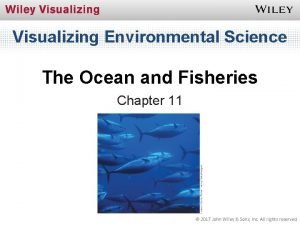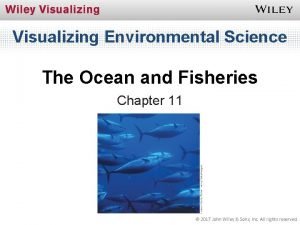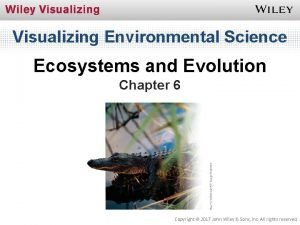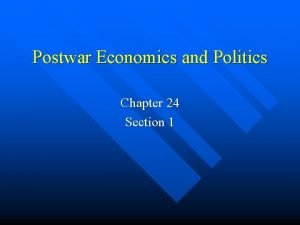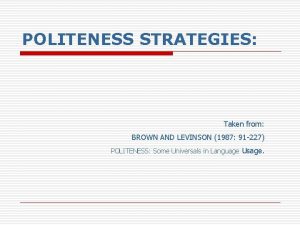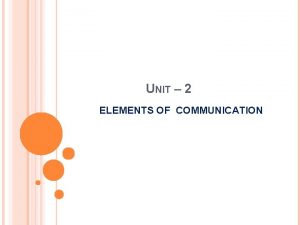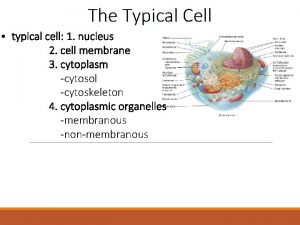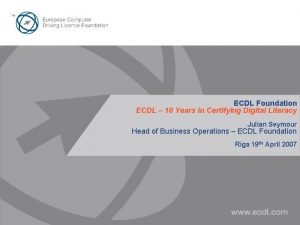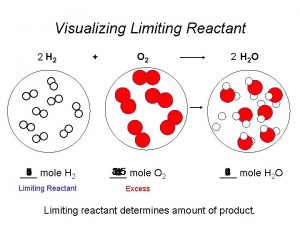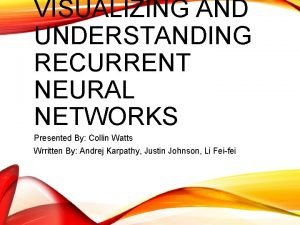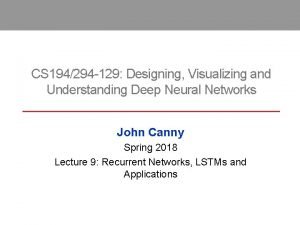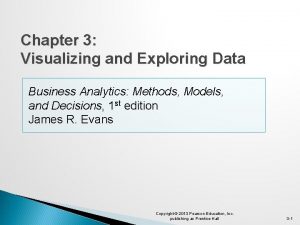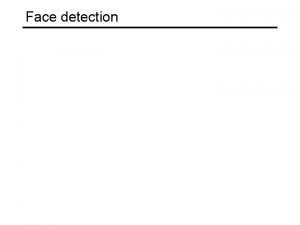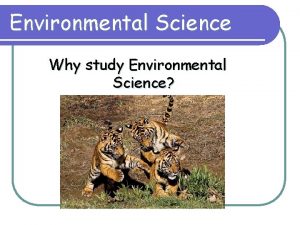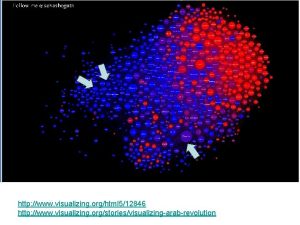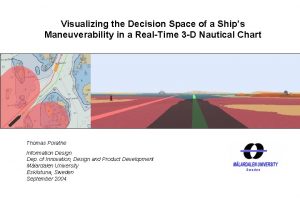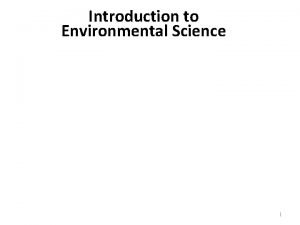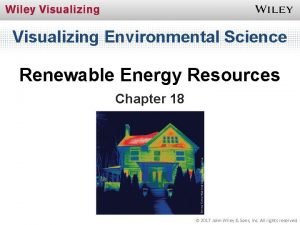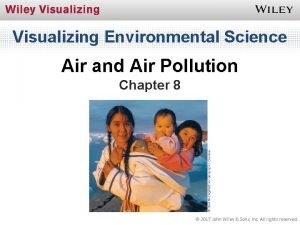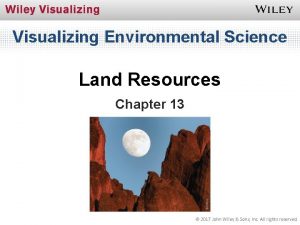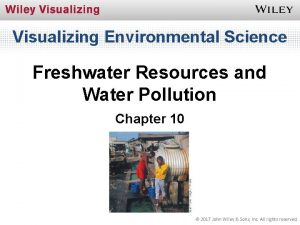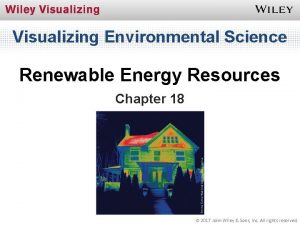Visualizing Environmental Science The Environmental Challenges We Face



































- Slides: 35

Visualizing Environmental Science The Environmental Challenges We Face Chapter A Copyright © 2017 John Wiley & Sons, Inc. All rights reserved.

A Rapidly Changing World • Humans are the dominant agent of environmental change – Humans transform the landscape – Increasing populations are overwhelming Earth’s regenerative capacity • Human activities have: – Disrupted habitats of thousands of species • In 2015, a total of 22, 784 species were classified as threatened worldwide – Profound effects on processes such as nutrient cycles and climate Copyright © 2017 John Wiley & Sons, Inc. All rights reserved.

Human Impacts on the Environment • Earth’s human population exceeded 7. 3 billion in 2015 – In 1960 = 3 billion; 1975 = 4 billion; 1987 = 5 billion • World population may stabilize by the end of the 21 st century – Population experts project anywhere from 7. 7 to 10. 6 billion, depending on how rapidly the fertility rate decreases – Current average fertility rate worldwide is 2. 5 children per woman – Fertility rates vary: 1. 7 in highly developed countries compared to 4. 5 in some of the least developed countries – Even with most countries’ active involvement with family planning, population growth rates take time to change Copyright © 2017 John Wiley & Sons, Inc. All rights reserved.

Human Impacts on the Environment • How many people the Earth can actually support is unknown – This will depend on our ability to develop sustainable agricultural practices that do not destroy the biological communities that support life on the planet – Consumption levels of materials and energy are also a factor • Globally, about 1. 5 billion people live in poverty – A condition in which people are unable to meet their basic needs for food, clothing, shelter, or health – Poverty is associated with: • Short life expectancy • Illiteracy • Inadequate access to health services, safe water, and balanced nutrition Copyright © 2017 John Wiley & Sons, Inc. All rights reserved.

Human Impacts on the Environment Human Population Growth It took thousands of years for the human population to reach 1 billion (in 1800). In 2015, Earth’s human population surpassed 7 billion. Copyright © 2017 John Wiley & Sons, Inc. All rights reserved.

The Gap Between Rich and Poor Countries • Countries are divided into rich and poor • Rich countries are known as highly developed countries – Highly developed countries represent 18% of the world’s population (US, Canada, Japan) – They have complex industrialized bases, low rates of population growth, and high person incomes. – People in highly developed countries consume more resources person than people in developing countries Copyright © 2017 John Wiley & Sons, Inc. All rights reserved.

The Gap Between Rich and Poor Countries • Poor countries are known as moderately developed countries (MDCs) or less developed countries (LDCs) • 82% of the world’s population live in either MDCs (such as Mexico, Turkey) or LDCs (such as Haiti, Bangladesh) – MDCs have: • Medium levels of industrialization • Lower person incomes, and fewer opportunities for education and health care than those in highly developed countries Copyright © 2017 John Wiley & Sons, Inc. All rights reserved.

The Gap Between Rich and Poor Countries – LDCs have: • Very low person incomes relative to those in highly developed countries • Low levels of industrialization, most economies are agricultural • High population growth rates • High infant mortality rates • Hunger, disease, and illiteracy are common Copyright © 2017 John Wiley & Sons, Inc. All rights reserved.

Population, Resources, and the Environment • The high rate of resource consumption in highly developed countries affects the environment as much as rapid population growth in other parts of the world – During rapid population growth, simply providing the essentials for survival can overwhelm a country’s natural resources • Often a situation found in developing countries • In highly developed countries, consumption of natural resources far exceeds amounts needed for basic survival – This depletion of resources extends past the boundaries of individual countries and can affect resources globally • Continued high-consumption lifestyles now rely on importation of resources from less developed countries to sustain them Copyright © 2017 John Wiley & Sons, Inc. All rights reserved.

Population, Resources, and the Environment • Types of resources: – Nonrenewable resources • Natural resources that are present in limited supplies and are depleted as they are used – Fossil fuels – Finite supply that took millions of years to form – Renewable resources • Resources that are replaced by natural processes and that can be used forever, provided they are not overexploited in the short term – Trees, soil, water – Potentially replaced by natural processes Copyright © 2017 John Wiley & Sons, Inc. All rights reserved.

Population, Resources, and the Environment • Population size and resource consumption: – At the same level of consumption, a larger population will consume more resources than a smaller one – However, globally, not all people consume the same amounts of resources • One child in a highly developed country has greater environmental impact than 20 children in a developing country • Highly developed nations represent less than 20% of the world’s population and consume more than half of the world’s resources: – – – 86% of the aluminum used 76% of timber harvested 68 percent of energy produced 61% of meat eaten 42% fresh water consumed Copyright © 2017 John Wiley & Sons, Inc. All rights reserved.

Population, Resources, and the Environment • Ecological footprint: – Amount of productive land, fresh air/water, and ocean, required to supply one person with food, wood, energy, water, housing, clothing, transportation, and waste disposal – Allotted global footprint 4. 3 acres • (Amount of Earth’s productive land water ÷ Global human population) – Average global footprint 6. 9 acres • This results in an ecological overshoot – Ecological footprints of countries (not individuals) vary depending on both population and consumption • France’s total footprint is 783. 6 million acres • The US’s total footprint is 6943 million acres Copyright © 2017 John Wiley & Sons, Inc. All rights reserved.

Population, Resources, and the Environment Ecological footprints The average ecological footprint of a person living in India, France, or the United States The total ecological footprint for India, France, and the United States Copyright © 2017 John Wiley & Sons, Inc. All rights reserved.

Population, Resources, and the Environment Ecological footprints Earth’s ecological footprint has been increasing over time. By 2010, humans were using the equivalent of 1. 5 Earths, a situation that is not sustainable Copyright © 2017 John Wiley & Sons, Inc. All rights reserved.

Population, Resources, and the Environment • Population, consumption, and environmental impact – Human impacts on the environment are difficult to assess – Mathematical models are utilized which use three most important factors to determine environmental impact: • The number of people (P). • The affluence person, which is a measure of the consumption, or amount of resources used person (A). • The environmental effects (resources needed and wastes produced) of the technologies used to obtain and consume the resources (T). – This assessment method is known as the IPAT model: • I = P × A × T. Copyright © 2017 John Wiley & Sons, Inc. All rights reserved.

Sustainability and the Environment • Sustainability: – The ability to meet humanity’s current needs without compromising future generations’ ability to meet their needs – Based on several ideas • Economic, social, and environmental well being must all be considered • We must consider effects of our actions on the environment • Earth’s resources are finite • Understanding environmental and social costs of our consumption • All Earth’s inhabitants have shared responsibility for living sustainably Copyright © 2017 John Wiley & Sons, Inc. All rights reserved.

Sustainability and the Environment • Currently, human society is not operating sustainably, due to: – Use of nonrenewable resources as if they were unlimited – Use of renewable resources faster than they can be replenished – We are polluting the environment with toxins as if its capacity to absorb them was limitless – Population continues to increase – Human activities disrupt many natural regenerative processes • Left unchecked, these activities may make recovery of many depleted natural systems impossible – Solutions are complex and challenging – Ecological, social, and economic factors interact, making sustainability difficult to achieve Copyright © 2017 John Wiley & Sons, Inc. All rights reserved.

Sustainability and the Environmental sustainability requires a long-term perspective to promote economic, social, and environmental well-being, such as the goals shown here Copyright © 2017 John Wiley & Sons, Inc. All rights reserved.

Enviro. Discovery: Green Roofs • Green roof: Partially or completely covered with vegetation and soil • Provide environmental benefits – Reduce heating costs in winter and cooling costs in summer – Filter rainwater pollutants – Reduce stormwater in sewers – Provide wildlife habitats • New York City has increasing numbers of green roofs Copyright © 2017 John Wiley & Sons, Inc. All rights reserved.

Global Environmental Issues • While climate variation is normal, global temperatures are increasing at an unprecedented rate • Climate is affected by human activities - Increased release of CO 2 and other greenhouse gases into the atmosphere - Industrial processes - Fossil fuel consumption - Deforestation - Land use change Copyright © 2017 John Wiley & Sons, Inc. All rights reserved.

Global Environmental Issues • 13 million hectares of forest lost annually • Loss of biodiversity • Loss of habitat for plants and animals • Deforested areas release CO 2 contributing to GCC • Deforestation affects local climates Copyright © 2017 John Wiley & Sons, Inc. All rights reserved.

Global Environmental Issues • Oceans cover two-thirds of the Earth’s surface and are home to half of the world’s biodiversity • Over 70% of the world’s commercial fish species are depleted or nearing depletion • 50% of coral reefs worldwide are threatened by human activity • Many factors cause ocean stresses - Overfishing Pollution Increased CO 2 emissions Global climate change Coastal development Copyright © 2017 John Wiley & Sons, Inc. All rights reserved.

Global Environmental Issues • Animal grazing and land converted for agriculture are main causes of desertification • Desertification causes – – – Loss of topsoil Increased soil salinity Damaged vegetation Regional climate change Decline in biodiversity Copyright © 2017 John Wiley & Sons, Inc. All rights reserved.

Global Environmental Issues Polar ice cap melting at accelerated rate Copyright © 2017 John Wiley & Sons, Inc. All rights reserved.

Global Environmental Issues No corner of the earth is immune to pollution. Copyright © 2017 John Wiley & Sons, Inc. All rights reserved.

Global Environmental Issues Ozone Depletion First noticed in the mid-1980’s the springtime “ozone hole” over the Antarctic continues to grow. Restricting chlorofluorocarbons (CFCs) and other ozone depleting chemicals have begun to level the rate of depletion. Stratospheric ozone shields the Earth from the sun’s ultraviolet radiation. Thinning of this protective layer can have devastating effects on Earth’s biological functions. Copyright © 2017 John Wiley & Sons, Inc. All rights reserved.

Environmental Science • Interdisciplinary study of humanity’s relationship with other organisms and the physical environment – Combines information from many fields • Biology, physics, geology, geography, chemistry, economics, sociology (including demography), cultural anthropology, agriculture, engineering, law, politics, and ethics. – Ecology is a basic tool of environmental science • The study of interrelationships between organisms and the environment – Atmospheric science – Environmental chemistry – Geosciences Copyright © 2017 John Wiley & Sons, Inc. All rights reserved.

The Goals of Environmental Science • Establish general principles about how the natural world functions • Develop viable solutions to environmental problems • Identify, understand, and solve problems that we as a society have created • Focus on solving problems based on scientific knowledge Copyright © 2017 John Wiley & Sons, Inc. All rights reserved.

Science as a Process • Solutions to environmental problems require comprehensive scientific information and evaluation Science is a body of knowledge AND a systematic process Science involves data collection and analysis/interpretation Science is not based on faith, emotion, or intuition Scientific observations and experiments must be repeatable and produce consistent data to be considered valid – Careful scrutiny by other scientists always part of the scientific process – Scientific understanding changes over time, as new experiments and new data are undertaken and gathered – – Copyright © 2017 John Wiley & Sons, Inc. All rights reserved.

Science as a Process • The Scientific Method: – The way a scientist approaches a problem, by formulating a hypothesis and then testing it – Five steps (see chart) Copyright © 2017 John Wiley & Sons, Inc. All rights reserved.

Science as a Process • The importance of prediction: – Scientists formulate hypotheses based on what they think to be true based on prior scientific work • • Hypotheses are predictions that can be tested by experimentation Try to test one variable at a time and hold other constant Experimental group vs. control group May lead to a theory – Theories are an integrated explanation of numerous hypotheses • Each included hypothesis is supported by many observations and experiments • Theories clarify and simplify our understanding of the natural world – Unfortunately, many environmental science questions are not able to be formulated as testable hypotheses Copyright © 2017 John Wiley & Sons, Inc. All rights reserved.

How We Handle Environmental Problems • There are five stages in addressing environmental problems 1. 2. 3. 4. 5. Scientific assessment Risk analysis Public engagement Political considerations Long-term environmental management Copyright © 2017 John Wiley & Sons, Inc. All rights reserved.

How We Handle Environmental Problems Copyright © 2017 John Wiley & Sons, Inc. All rights reserved.

Enviro. Discovery: NIMBY • NIMBY = Not In My Back Yard • Waste disposal sites are always controversial – Hazardous or dangerous waste sites are especially difficult to site – Frequent failure by developers and public planners to engage residents in decision-making process • Yucca Mountain in Nevada – Nuclear waste • More sophisticated approaches to waste disposal siting necessary in future Copyright © 2017 John Wiley & Sons, Inc. All rights reserved.

Case Study: The New Orleans Disaster • Hurricane Katrina, August 2005 – Increased damage due to human alteration of the natural landscape – Man-made canals facilitated salt water killing marsh vegetation – Levees prevented sediment deposition – Settlements were built on drained wetlands – New Orleans sinking due to lack of bedrock, resulting from resource removal This satellite image shows flooding in New Orleans following Hurricane Katrina. Along the left (west) side is a levee from Lake Pontchartrain (top) that failed so that water inundated the New Orleans area east of the levee. Areas on the far left top remained dry. Part of the Mississippi River is shown at lower center. Copyright © 2017 John Wiley & Sons, Inc. All rights reserved.
 Visualizing environmental science solution manual
Visualizing environmental science solution manual El nino enso
El nino enso Visualizing environmental science (doc or html) file
Visualizing environmental science (doc or html) file Rule of 70 population growth
Rule of 70 population growth What challenges did madison face abroad
What challenges did madison face abroad Henry hudson face
Henry hudson face Key issue 3 why do some places face health challenges
Key issue 3 why do some places face health challenges What challenges did calvin coolidge face
What challenges did calvin coolidge face What is your favourite subject?
What is your favourite subject? Preference structure in pragmatics
Preference structure in pragmatics Off record politeness
Off record politeness Face-to-face narrative examples
Face-to-face narrative examples Perspectives in communication
Perspectives in communication Barbara cons
Barbara cons Face theory brown and levinson
Face theory brown and levinson Whats this shape
Whats this shape Example of a simile in romeo and juliet
Example of a simile in romeo and juliet Cis face and trans face
Cis face and trans face Myron b thompson academy
Myron b thompson academy Ecdl foundation
Ecdl foundation Mesopotamia environmental challenges
Mesopotamia environmental challenges What is visualizing?
What is visualizing? Limiting reactant
Limiting reactant Visualizing japanese grammar
Visualizing japanese grammar Visualizing and verbalizing structure words
Visualizing and verbalizing structure words Visualizing and understanding recurrent networks
Visualizing and understanding recurrent networks Visualizing and understanding convolutional neural networks
Visualizing and understanding convolutional neural networks Cs 231 n
Cs 231 n Performance lawn equipment case study
Performance lawn equipment case study 1-1 practice nets and drawings for visualizing geometry
1-1 practice nets and drawings for visualizing geometry What is visualizing
What is visualizing Visualizing and understanding neural machine translation
Visualizing and understanding neural machine translation Analyzing and visualizing data with microsoft power bi
Analyzing and visualizing data with microsoft power bi Nets and drawing for visualizing geometry
Nets and drawing for visualizing geometry Nets and drawings for visualizing geometry
Nets and drawings for visualizing geometry Nets and drawings for visualizing geometry
Nets and drawings for visualizing geometry
